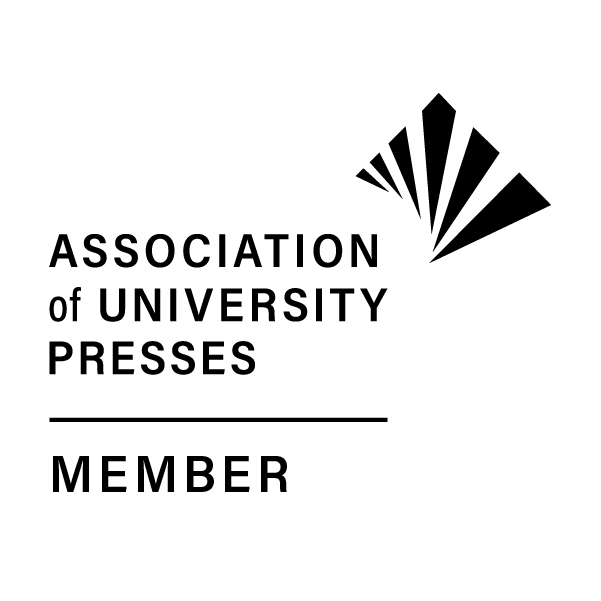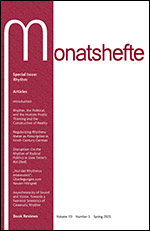|


|

Subscribe
Read the Journal Online
Submission Guidelines
Editorial Board
Receive Email Updates
Advertise in Monatshefte
Indexes/Abstracts
Current Issue TOC
Back Issues TOC
Monatshefte 2022 Subscription Rates
Institutions:
print & online $271
online only $233
Individuals:
print & online $103
online only $86
Non U.S. Postage (no postage charges for online-only subscriptions)
Airmail: add $40/yr.
Canadian Subscribers: add 5% GST. |
Monatshefte
Volume 114, Number 3, Fall 2022
Table of Contents
Special Issue: Slowness, Untimeliness, Rupture: Queer Time and History in German Studies
ARTICLES
Kyle Frackman and Ervin Malakaj
Introduction: Approaches to Queer Temporalities in German Studies
Birgit Lang and Katie Sutton
An Ethics of Attentiveness: Photographic Portraits and Deviant Dwelling in German Queer and Trans Archives
Photographic portraits of queer subjects from the early 20th century—shaped by early medical-scientific and legal practices—have often been identified with hegemonic ways of seeing, even when they are restaged in the present. In this article we argue that bringing an ethics of attentiveness to the analysis of such photographs reveals not only how embodied subjectivities were captured by the photographer’s lens, but also how our own feelings and sense of self shape our investments in “touching” the queer past. Attending to such “quiet frequencies” (Campt) of the queer photographic archive allows us to embrace a wide range of emotions, from shame, desire, and grief to desire, exhibitionism, and self-assurance. We argue that through their portraits, the queer subjects examined in our article lay claim to a form of “deviant dwelling” that incorporates a tension between pragmatism, conformity, and refusal. This tension resonates into the present, as curators and artists recirculate and cite archival genres of queer portraiture. In doing so, they create moments of transtemporal queer touch between today’s audiences and historical subjects, albeit in ways that do not always sit comfortably with contemporary attempts at queer world-making. (BL/KS)
Adrienne Merritt
The Queer Temporalities of Sadomasochism in Robert Musil’s Törless
This article explores the ways in which sadomasochism (S/M) performs on the level of content and form in Robert Musil’s Die Verwirrungen des Zöglings Törless (1906). The interconnecting yet disjointed literary tableaux in Törless are drawn together through tensions developed by the interplay between what Nicole McCleese calls sadistic time (accelerated and authoritative narrative temporality) and masochistic time (a poetics of delay, suspense, and waiting). Reading sadism and masochism across the narrative exposes the multivariant form of S/M, one that achieves both literalized and symbolic ends. This reading is situated squarely within queer interpretations of sadomasochism, suggesting that, despite the authorial narrator’s claims, Törless’s path after the cadet school can only be read as a queer phenomenological turn. The reading of sadomasochism in Törless is tied to a metacommentary, concerned with the anxieties associated with modernity. (AM)
Domenic DeSocio
Friends with Benefits: Friendship and Queer Temporality in Klaus Mann’s Der fromme Tanz (1926) and Siegfried Kracauer’s Georg (1934)
What notions and experiences of time does queer friendship cultivate? I analyze Klaus Mann’s Der fromme Tanz (1926) and Siegfried Kracauer’s Georg (1934/73) to argue that the queer friendships depicted in these novels evoke temporalities of continuity, non-fragmentation, and coherency imbued with a robust sense of tradition. Offering close readings contextualized within the history of Western discourses on male friendship and contemporary queer theoretical debates about temporality and sexuality, I demonstrate how these authors portray two different models of queer friendship as hybrid solutions of romantic, erotic, and friendly affects and desires. From these unique combinations their relationships emerge as sites of and tools for engendering new temporalities and temporal lifeworlds around an enduring present. In foregrounding alternative forms of queer relationality and time, I contribute to recent scholarship on queer time, expanding our scope beyond commonly studied romantic-sexual relationships and their temporalities of disruption and discontinuity. (DD)
Simone Stirner
Untimely Belongings: Queer Temporalities in the Wake of National Socialism
This article brings the discussion of queer temporalities to a field from which it has been strikingly absent: Remembrance after National Socialism. Taking a cue from Yael Bartana’s strategy of “transhistorical queering” in her 2021 piece Malka Germania, the study investigates the potential of queer temporalities for memory in the wake of National Socialism by focusing on two stylistically divergent works: Ulrike Ottinger’s film Freak Orlando (1981) that weaves together a network of stories set against frameworks of institutionalized violence and May Ayim’s poem “deutschland im herbst” (1992) that refracts the history of National Socialism through contemporary realities of racist violence in the 1990s, remembering injustices toward gays and lesbians along the way. In both the film and the poem, a temporally queer aesthetic destabilizes linear notions of remembrance that consider the past to be past, and challenges us to reimagine a form of memory in the wake of National Socialism that proceeds through practices of solidarity and through an active interrogation of the present. (SS)
Kyle Frackman
Slow Aesthetics, Fraught Intimacy, and Queer Time in the German Queer New Wave: Sturmland and Neubau
This article analyzes two contemporary German films for their use of slow aesthetic techniques and their engagement with displays of and challenges to notions of intimacy. Appealing to the critical concept of “precarious intimacies,” the article argues that Sturmland (2014, directed by Ádám Császi) and Neubau (2020, directed by Johannes Maria Schmit) employ techniques of slow cinema to manipulate the films’ use, and the audience’s perception, of queer temporality. The two films are part of a transnational new wave of queer cinema first identified in 2012 and show hallmarks of slow cinema like long takes, elliptical dialog, sparse non-diegetic soundtracks, and other elements that foster a contemplative tone. Sturmland and Neubau concentrate on diverse intimate circumstances in their plots, which demonstrate that both the narrative and the medium have ramifications for perceptions of queer potential, eroticism, non-conforming gender, and physical expressions of desire. (KF)
Robert D. Tobin
Queer German Roots of the Alt-Right: Ulrichs, Weininger, Blüher—and Evola
Julius Evola, the Italian fascist philosopher who has become a touchstone for far-right thinking throughout the world, has surprising connections to figures in the early German homosexual emancipation movement. From Karl Heinrich Ulrichs, he draws on the idea that men can have female souls and women can have male souls. From Otto Weininger, he adapts the idea of taking this kind of gender inversion and applying it to race. From Hans Blüher, he draws on the glorification of the Männerbund, an erotically bonded group of men, as the basic building block of society. The unexpected queer roots of alt-right thinking help to explain the presence of gay men and women on the far right, outlining a reactionary queer genealogy that contrasts with liberal progressive LGBTQ+ histories. (RDT).
BOOK REVIEWS
Attanucci, Timothy, The Restorative Poetics of a Geological Age: Stifter, Viollet-le-Duc, and the Aesthetic Practices of Geohistoricism (Helga G. Braunbeck)
Block, Friedrich W. und Uwe Wirth, Hrsg., Grenzen der Komik. Ergebnisse des Kasseler Komik-Kolloquiums (Alan Lareau)
Börnchen, Stefan und Claudia Liebrand, Hrsg., Lauschen und Überhören. Literarische und mediale Aspekte auditiver Offenheit (Rolf J. Goebel)
Dornbach, Márton, The Saving Line: Benjamin, Adorno, and the Caesura of Hope (Marcus Bullock)
Fricke, Anna, Eugen Napoleon Neureuthers Randzeichnungen. Eine kritische Refexion seiner Position (Monika Schmitz-Emans)
Funkenstein, Susan, Marking Modern Movement: Dance and Gender in the Visual Imagery of the Weimar Republic (Kristen Hylenski)
Gerhalter, Li, Tagebücher als Quellen. Forschungsfelder und Sammlungen seit 1800 (Pia Schmid)
Haselbeck, Sebastian, Gespenstische Souveränität. Zur politischen Einbildungskraft zwischen 1910 und 1920 (Roman Gleissner)
Herges, Katja and Elisabeth Krimmer, eds., Contested Selves: Life Writing and German Culture (Sebastian Brass)
Hintz, Ernst Ralf and Scott E. Pincikowski, eds., The End-Times in Medieval German Literature: Sin, Evil, and the Apocalypse (Christopher R. Clason)
Malchow, Timothy B., Günter Grass and the Genders of German Memory: From The Tin Drum to Peeling the Onion (Regine Criser)
Martin, Marko, Die verdrängte Zeit. Vom Verschwinden und Entdecken der Kultur des Ostens (Stephen Brockmann)
Oberle, Eric, Theodor Adorno and the Century of Negative Identity (J.D. Mininger)
Schaumann, Caroline, Peak Pursuits: The Emergence of Mountaineering in the Nineteenth Century (Carmel Heeley)
Schönthaler, Philipp, Die Automatisierung des Schreibens &
Gegenprogramme der Literatur (Peter Krapp)
Steinby, Liisa, Hrsg., Herder und das 19. Jahrhundert / Herder and the
Nineteenth Century (John H. Zammito)
Thurman, Kira, Singing Like Germans: Black Musicians in the Lands of Bach, Beethoven, and Brahms (Jonathan Wipplinger)
Vogt, Jochen, Schema und Variation. 13 Versuche zum Kriminalroman (Sabine Gross)
Weitzman, Erica, At the Limit of the Obscene: German Realism and the Disgrace of Matter (Hans J. Rindisbacher)
Wernli, Martina, Federn lesen. Eine Literaturgeschichte des Gänsekiels von den Anfängen bis ins 19. Jahrhundert (Sebastian Böhmer)
|

